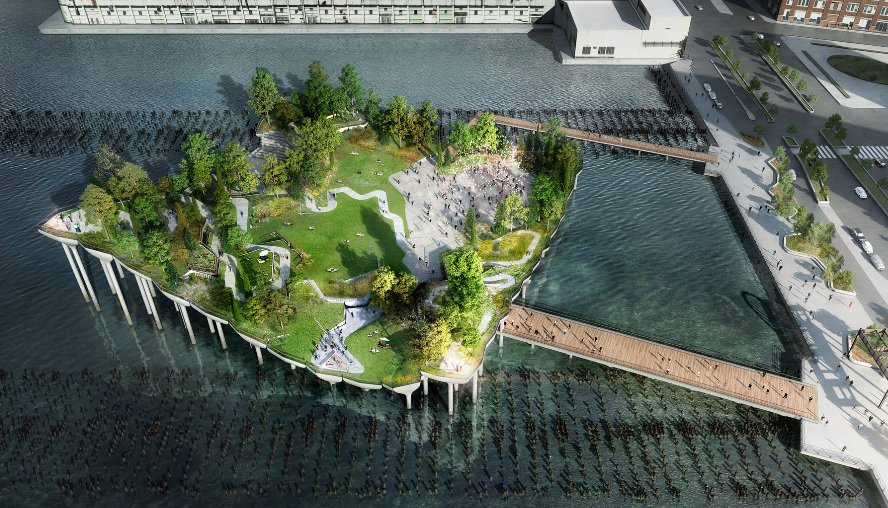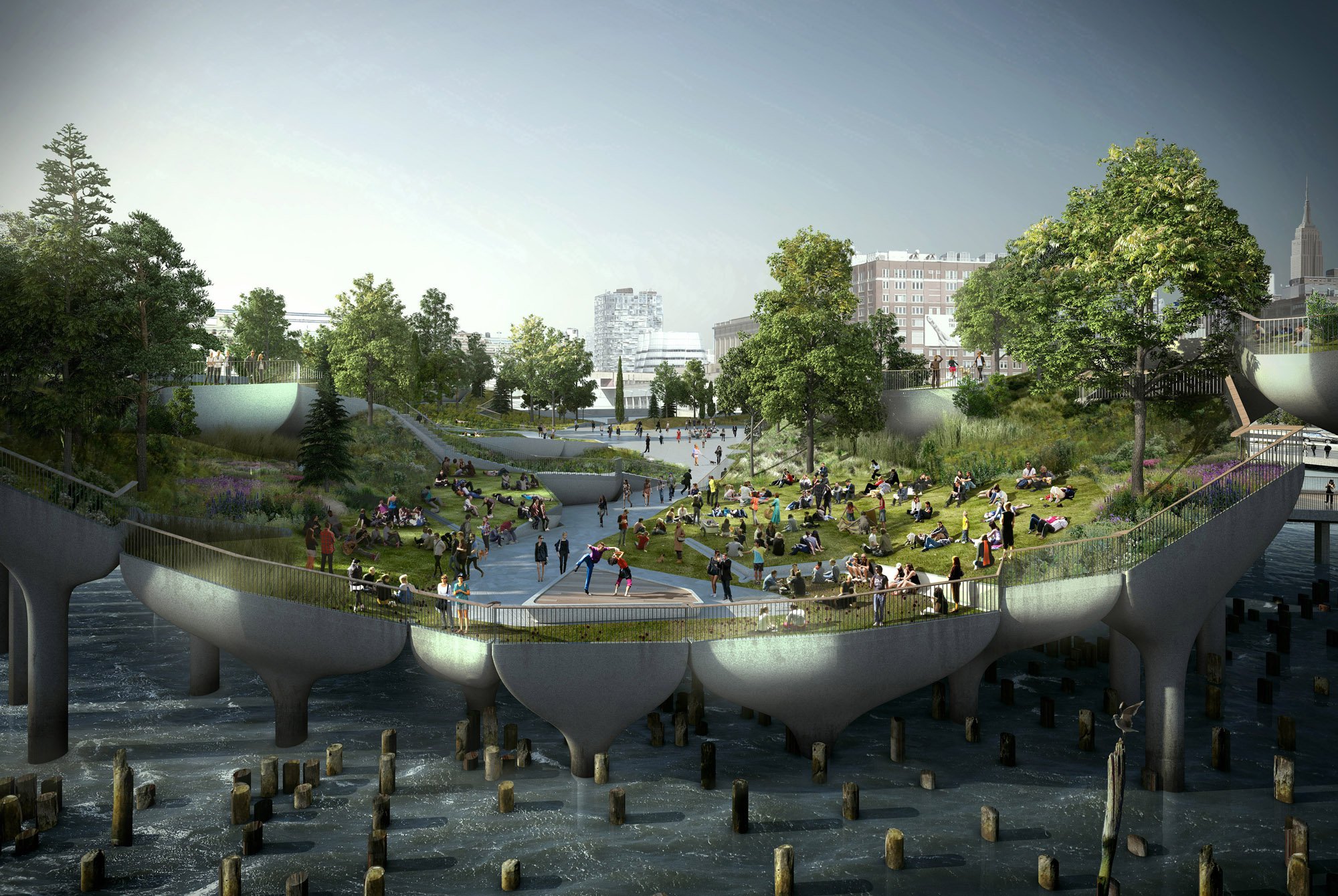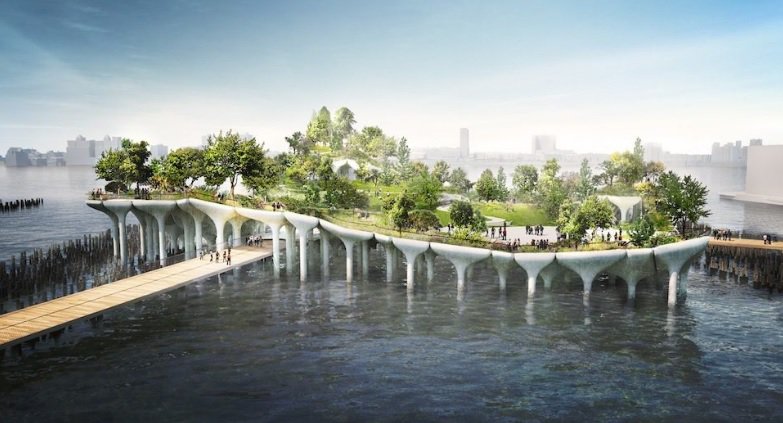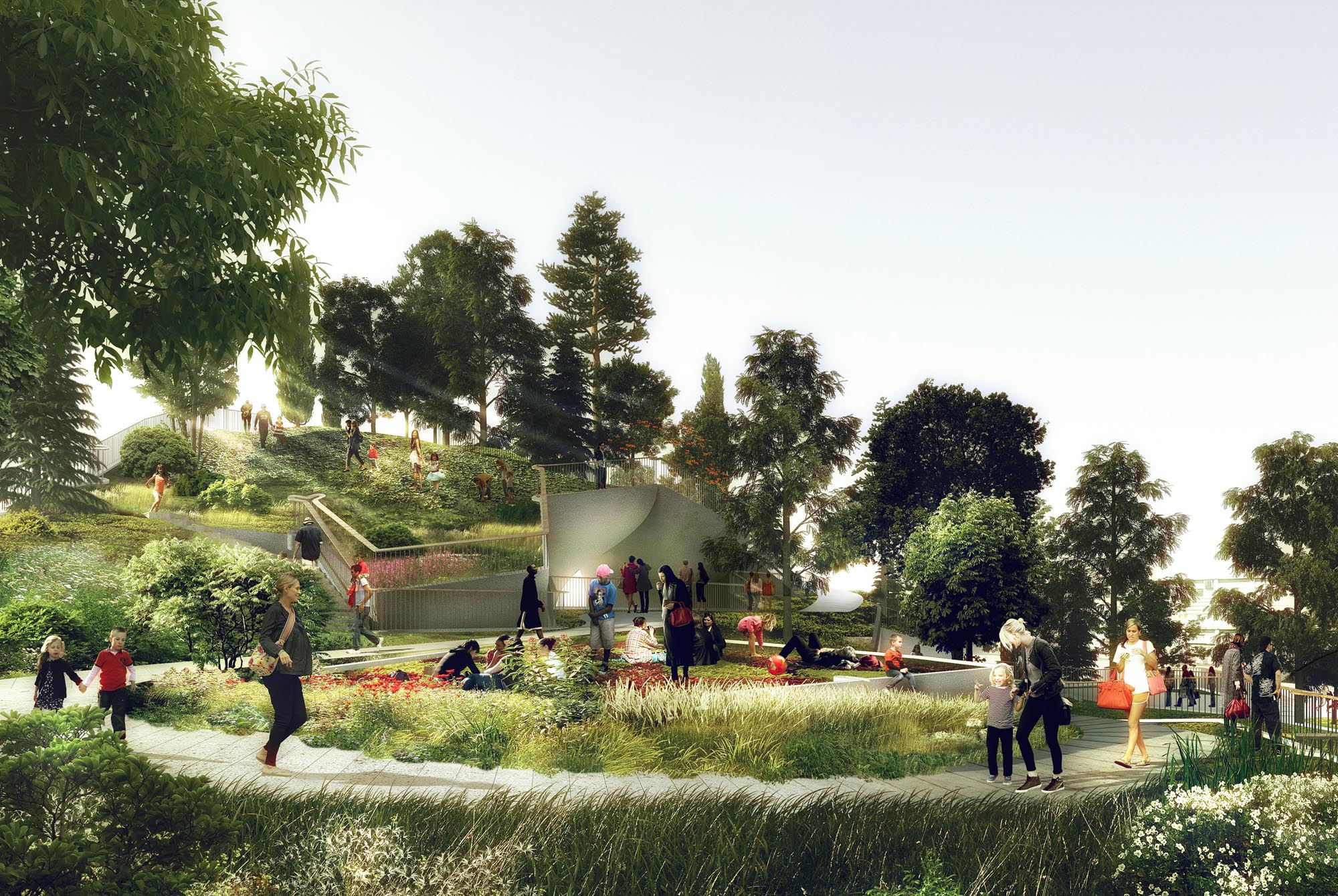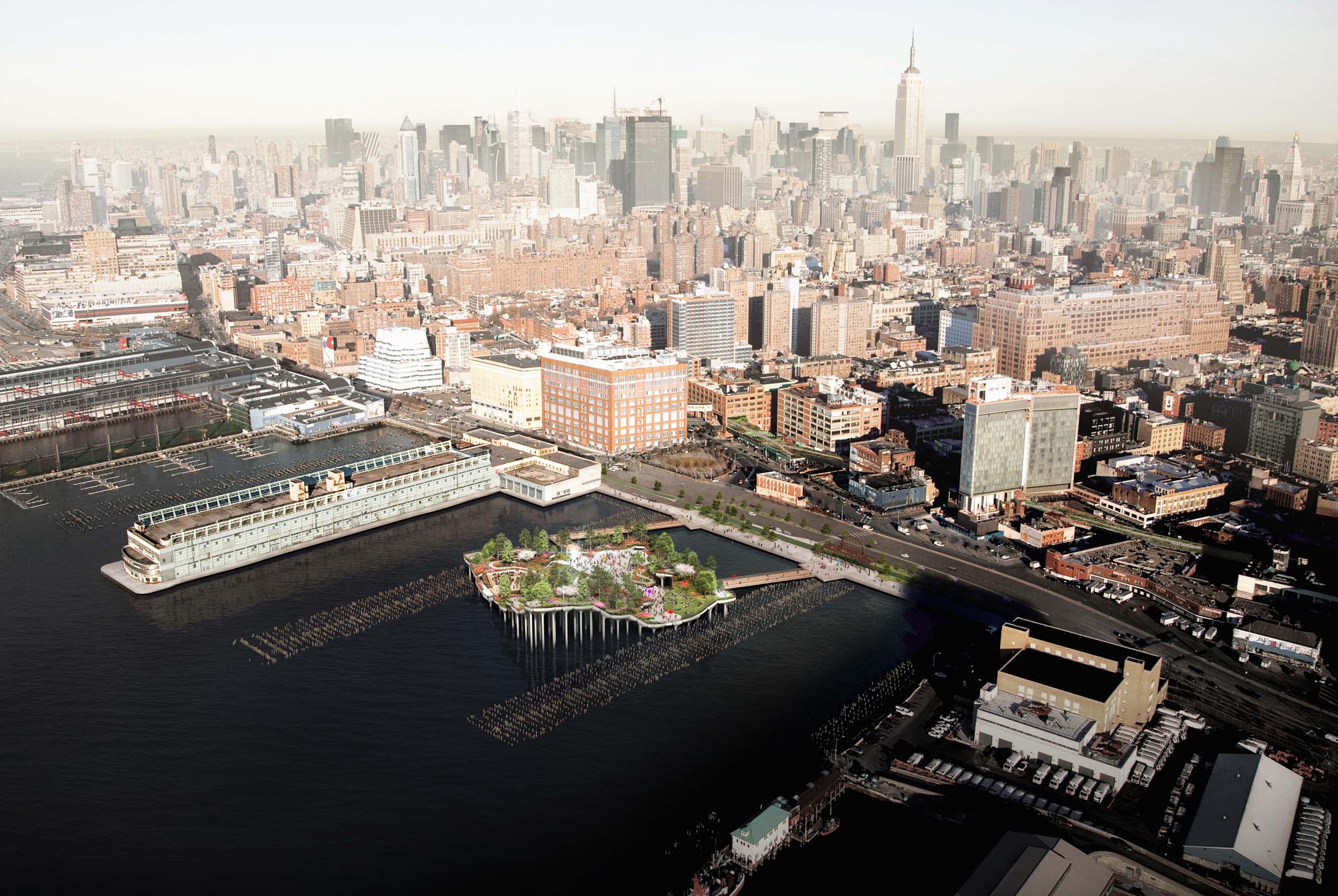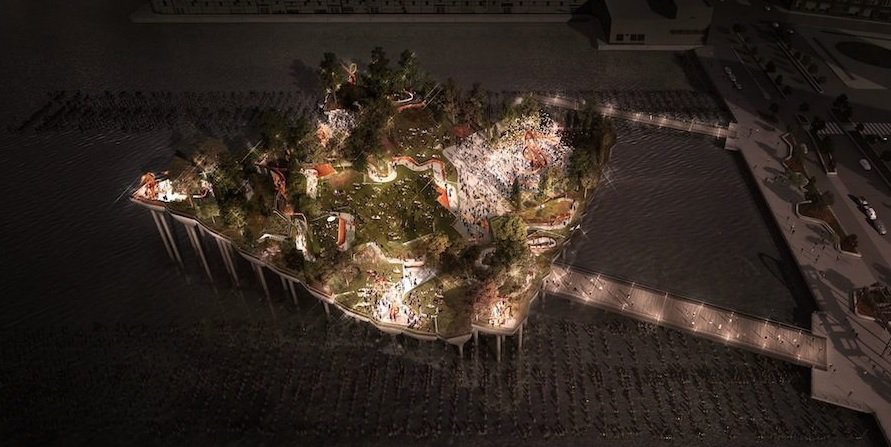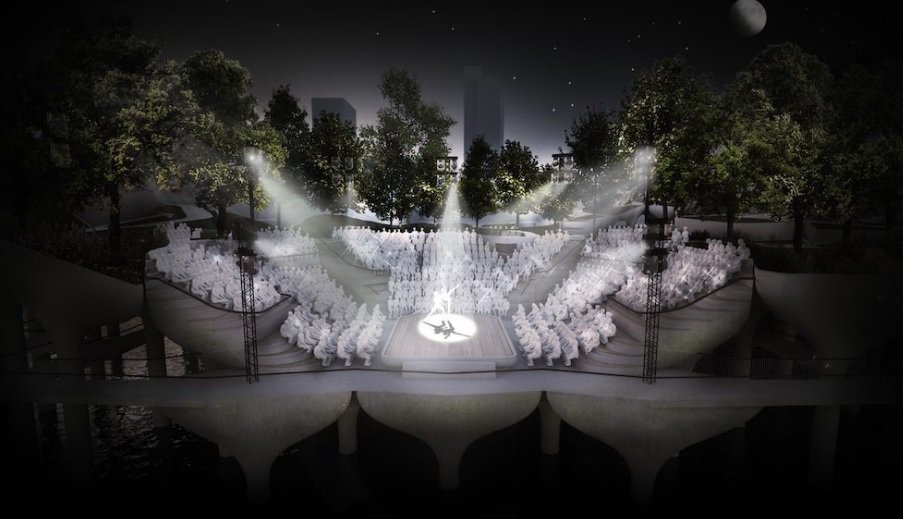When people are looking for public space in New York City, they often look to the waterways. Of the many ideas in this vein, a new one is more ambitious than usual: an offshore park proposed for the Hudson River off of 14th Street.
Initial pricing puts the project, called Pier 55, at $170 million, and the proposal states that it would be located 186 feet from land and contain wooded areas and three performance venues, 6sqft reports.
Barry Diller, the billionaire Chairman of IAC, is sponsoring the plan. In fact, he initiated the design competition that produced this proposal. Thomas Heatherwick of Heatherwick Studio is responsible for the current plan for proposed park.
Diller has promised $130 million from the Diller-von Furstenberg Family Foundation, in addition to taking managerial responsibilities for the outdoor space and operating costs for the first 20 years. A veteran supporter of public projects, Diller was also the single largest donor to the High Line. The rest of the necessary funds, about $39.5 million, are to come from the city, state, and the Hudson River Park Trust.
Before the plan can go forward, the board of the Hudson River Park Trust, the Army Corps of Engineers, and the New York Department of Environmental Conservation must approve Pier 55.
Heatherwick's winning proposal for the park is based on 300 mushroom-shaped concrete columns, forming a parallelogram shape when combined. These columns would vary in height, making the park closer to the water in some places. This design allows sunlight to enter beneath the park, which is vital for the marine sanctuary in this area of the river.
The largest of the three proposed performance spaces would hold 1,000 people in the seats and 2,500 more on the lawn. The other two spaces would be an 800-seat amphitheater and a small stage with 250 seats.
Renderings courtesy Heatherwick Studios.
Related Stories
| Aug 11, 2010
Portland Cement Association offers blast resistant design guide for reinforced concrete structures
Developed for designers and engineers, "Blast Resistant Design Guide for Reinforced Concrete Structures" provides a practical treatment of the design of cast-in-place reinforced concrete structures to resist the effects of blast loads. It explains the principles of blast-resistant design, and how to determine the kind and degree of resistance a structure needs as well as how to specify the required materials and details.
| Aug 11, 2010
Jacobs, CH2M Hill, AECOM top BD+C's ranking of the 75 largest federal government design firms
A ranking of the Top 75 Federal Government Design Firms based on Building Design+Construction's 2009 Giants 300 survey. For more Giants 300 rankings, visit http://www.BDCnetwork.com/Giants
| Aug 11, 2010
Manhattan's Pier 57 to be transformed into cultural center, small business incubator, and public park as part of $210 million redevelopment plan
LOT-EK, Beyer Blinder Belle, and West 8 have been selected as the design team for Hudson River Park’s Pier 57 at 15th Street and the Hudson River as part of the development group led by New York-based real estate developer YoungWoo & Associates. The 375,000 square foot vacant, former passenger ship terminal will be transformed into a cultural center, small business incubator, and public park, including a rooftop venue for the Tribeca Film Festival.
| Aug 11, 2010
Gensler, HOK, HDR among the nation's leading reconstruction design firms, according to BD+C's Giants 300 report
A ranking of the Top 100 Reconstruction Design Firms based on Building Design+Construction's 2009 Giants 300 survey. For more Giants 300 rankings, visit http://www.BDCnetwork.com/Giants
| Aug 11, 2010
Bowdoin College Museum of Art
Brunswick, Maine
Since its founding in 1794, when what is now the state of Maine was still part of the Commonwealth of Massachusetts, Bowdoin College has played a pivotal role in the educational and cultural life of Maine. Contributing to that role for more than a century has been the Walker Art Building, an 1894 McKim, Mead & White-designed structure and home to the college’s Museum of Art.
| Aug 11, 2010
Gensler among eight teams named finalists in 'classroom of the future' design competition
Eight teams were recognized today as finalists of the 2009 Open Architecture Challenge: Classroom. Finalists submitted designs ranging from an outdoor classroom for children in inner-city Chicago, learning spaces for the children of salt pan workers in India, safe spaces for youth in Bogota, Colombia and a bamboo classroom in the Himalayan mountains.
| Aug 11, 2010
ASHRAE introduces building energy label prototype
Most of us know the fuel efficiency of our cars, but what about our buildings? ASHRAE is working to change that, moving one step closer today to introducing its building energy labeling program with release of a prototype label at its 2009 Annual Conference in Louisville, Ky.
| Aug 11, 2010
Thom Mayne unveils 'floating cube' design for the Perot Museum of Nature and Science in Dallas
Calling it a “living educational tool featuring architecture inspired by nature and science,” Pritzker Prize Laureate Thom Mayne and leaders from the Museum of Nature & Science unveiled the schematic designs and building model for the Perot Museum of Nature & Science at Victory Park. Groundbreaking on the approximately $185 million project will be held later this fall, and the Museum is expected to open by early 2013.
| Aug 11, 2010
Theater Renovation—A First-Class Production
In 1985, the city of San Diego ordered the historic Balboa Theatre, its beleaguered performing arts center, to be shuttered due to seismic safety concerns. It would take another two decades to restore the landmark building.


